人教版(2019)必修第三册Unit 1 Festivals and Celebrations Discovering Useful Structures 非谓语动词 V-ING课件(共30张PPT)
文档属性
| 名称 | 人教版(2019)必修第三册Unit 1 Festivals and Celebrations Discovering Useful Structures 非谓语动词 V-ING课件(共30张PPT) | 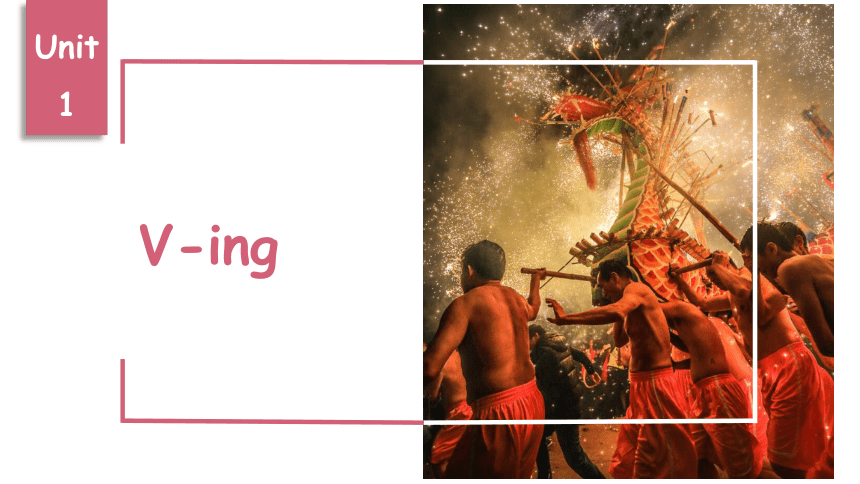 | |
| 格式 | pptx | ||
| 文件大小 | 1.5MB | ||
| 资源类型 | 教案 | ||
| 版本资源 | 人教版(2019) | ||
| 科目 | 英语 | ||
| 更新时间 | 2024-04-24 10:41:31 | ||
图片预览

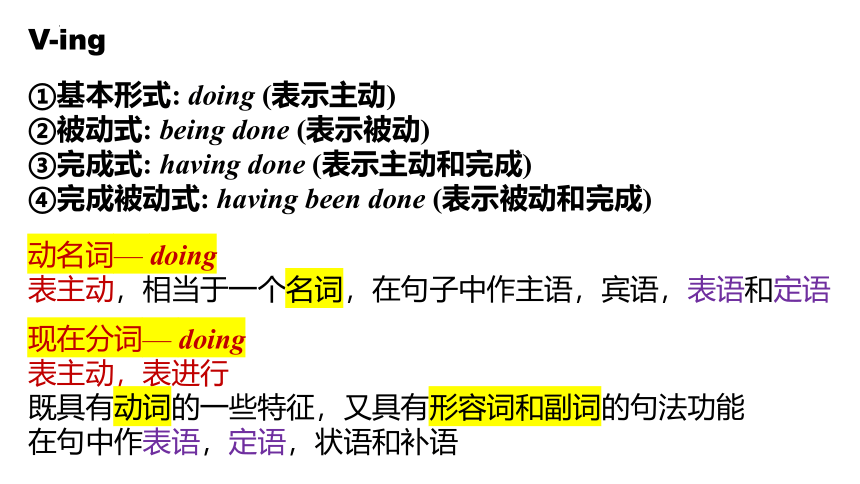

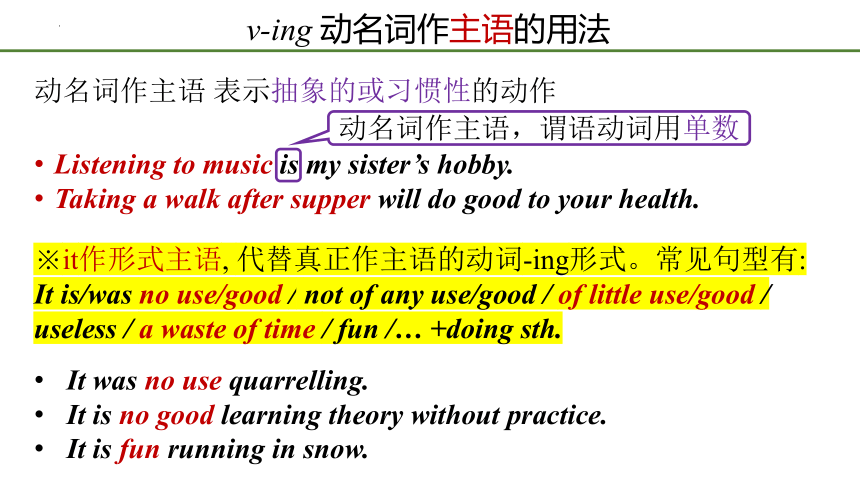
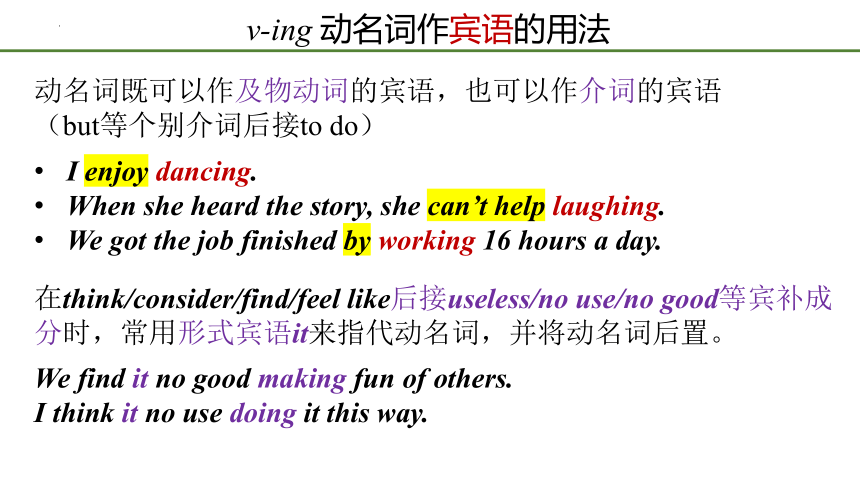
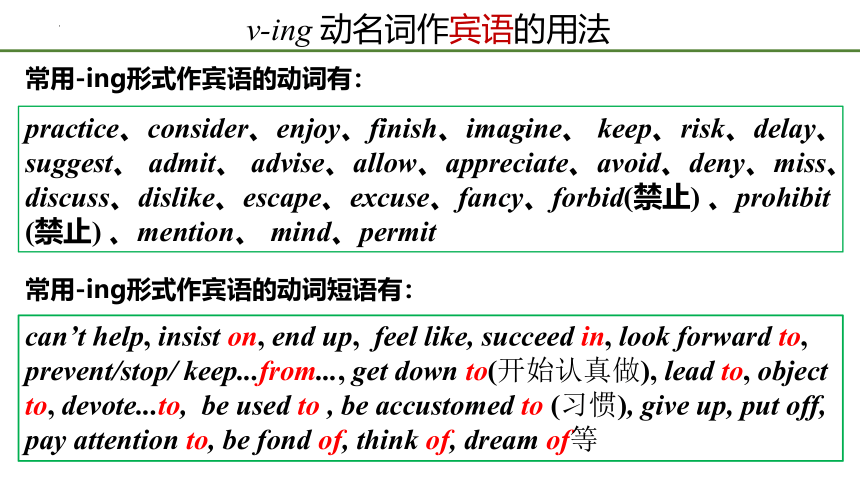
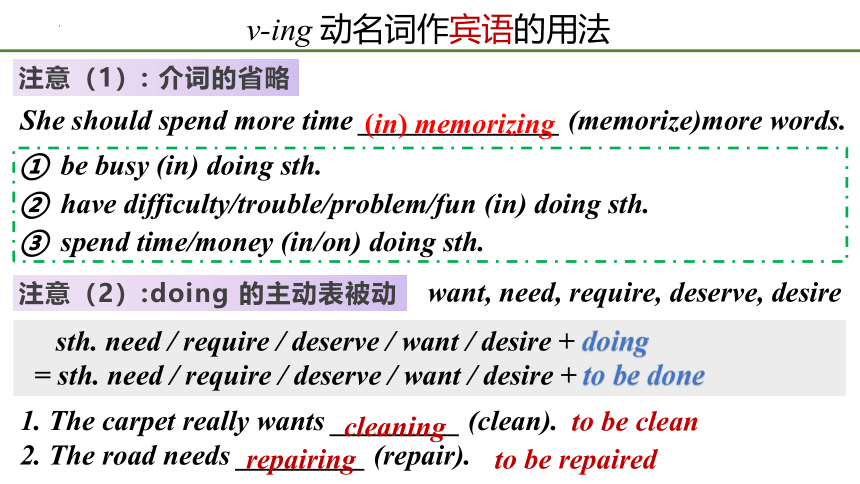
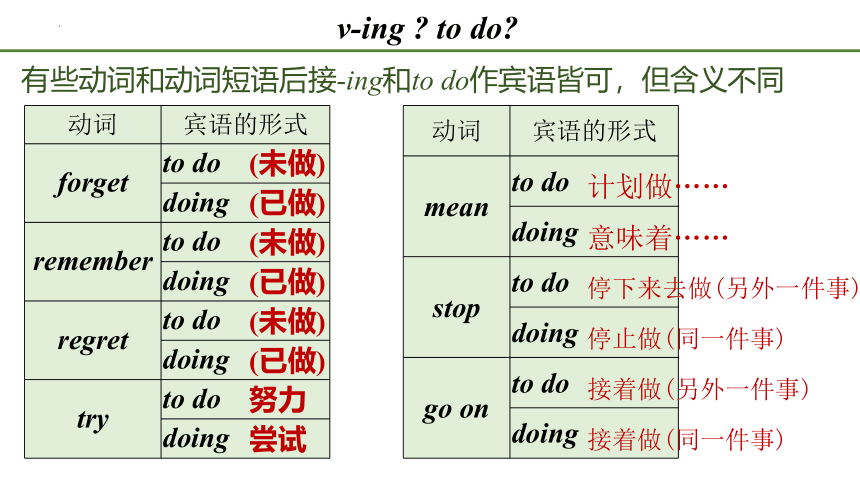
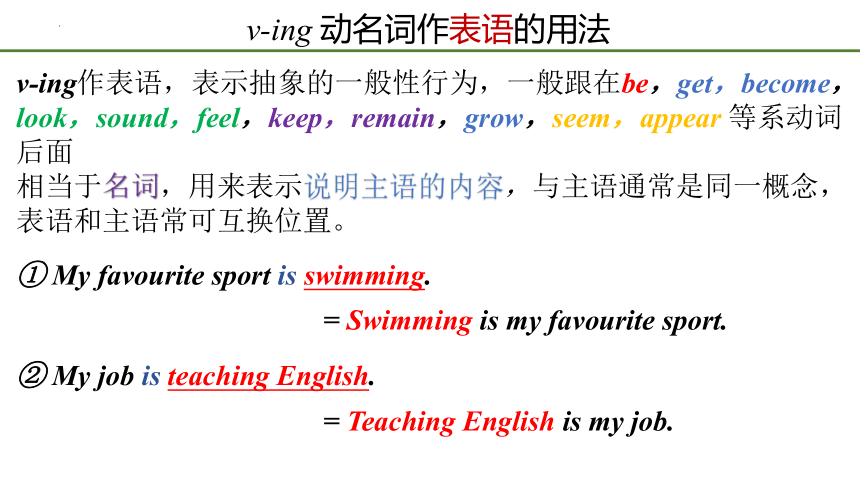
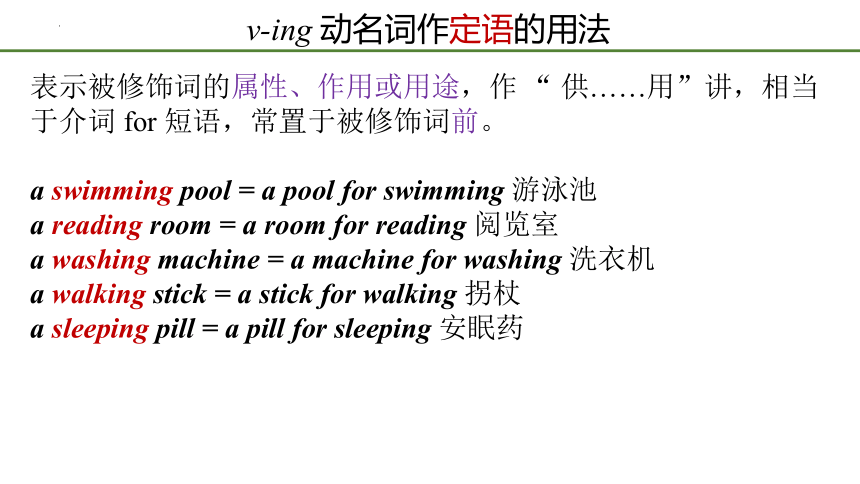
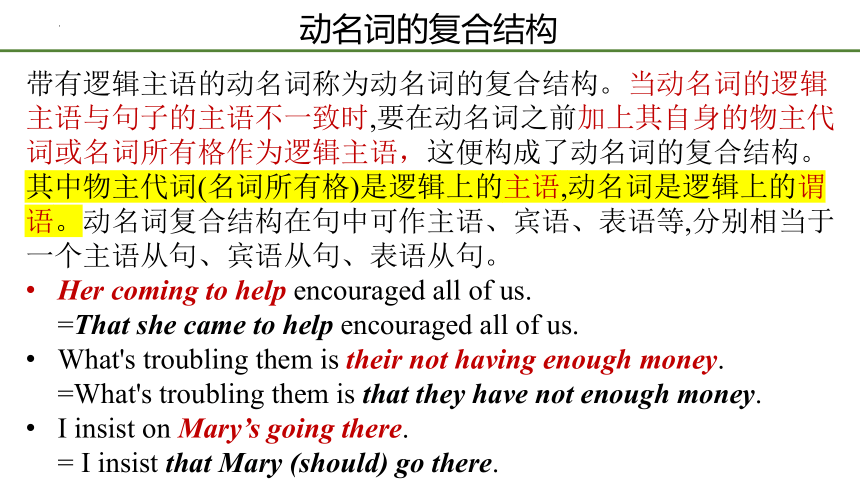
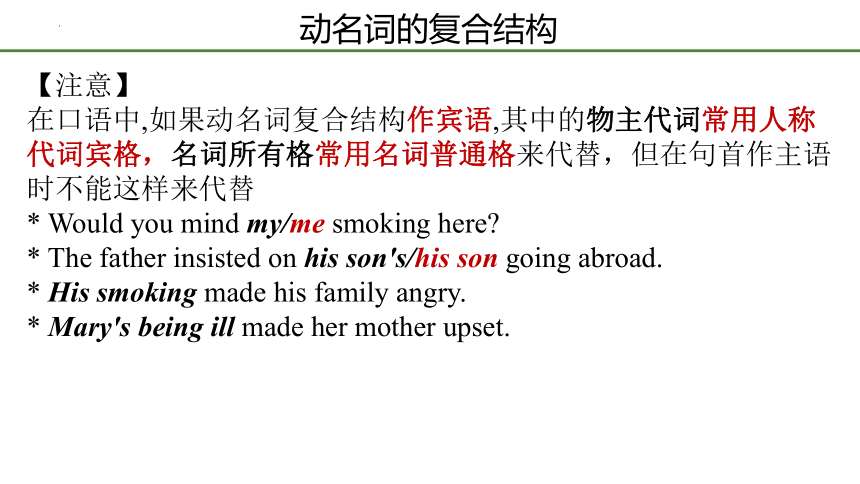
文档简介
(共30张PPT)
V-ing
Unit
1
①基本形式: doing (表示主动)
②被动式: being done (表示被动)
③完成式: having done (表示主动和完成)
④完成被动式: having been done (表示被动和完成)
V-ing
动名词— doing
表主动,相当于一个名词,在句子中作主语,宾语,表语和定语
现在分词— doing
表主动,表进行
既具有动词的一些特征,又具有形容词和副词的句法功能
在句中作表语,定语,状语和补语
动名词
v-ing 动名词作主语的用法
动名词作主语 表示抽象的或习惯性的动作
Listening to music is my sister’s hobby.
Taking a walk after supper will do good to your health.
※it作形式主语, 代替真正作主语的动词-ing形式。常见句型有:
It is/was no use/good / not of any use/good / of little use/good / useless / a waste of time / fun /… +doing sth.
It was no use quarrelling.
It is no good learning theory without practice.
It is fun running in snow.
动名词作主语,谓语动词用单数
v-ing 动名词作宾语的用法
动名词既可以作及物动词的宾语,也可以作介词的宾语(but等个别介词后接to do)
I enjoy dancing.
When she heard the story, she can’t help laughing.
We got the job finished by working 16 hours a day.
在think/consider/find/feel like后接useless/no use/no good等宾补成分时,常用形式宾语it来指代动名词,并将动名词后置。
We find it no good making fun of others.
I think it no use doing it this way.
v-ing 动名词作宾语的用法
常用-ing形式作宾语的动词有:
practice、consider、enjoy、finish、imagine、 keep、risk、delay、suggest、 admit、 advise、allow、appreciate、avoid、deny、miss、discuss、dislike、escape、excuse、fancy、forbid(禁止) 、prohibit (禁止) 、mention、 mind、permit
常用-ing形式作宾语的动词短语有:
can’t help, insist on, end up, feel like, succeed in, look forward to, prevent/stop/ keep...from..., get down to(开始认真做), lead to, object to, devote...to, be used to , be accustomed to (习惯), give up, put off, pay attention to, be fond of, think of, dream of等
v-ing 动名词作宾语的用法
注意(1): 介词的省略
She should spend more time ______________ (memorize)more words.
be busy (in) doing sth.
have difficulty/trouble/problem/fun (in) doing sth.
spend time/money (in/on) doing sth.
(in) memorizing
注意(2):doing 的主动表被动
want, need, require, deserve, desire
1. The carpet really wants _________ (clean).
2. The road needs _________ (repair).
sth. need / require / deserve / want / desire + doing
= sth. need / require / deserve / want / desire + to be done
cleaning
repairing
to be clean
to be repaired
v-ing to do
有些动词和动词短语后接-ing和to do作宾语皆可,但含义不同
动词 宾语的形式
forget to do
doing
remember to do
doing
regret to do
doing
try to do
doing
(未做)
(已做)
(未做)
(已做)
(未做)
(已做)
努力
尝试
动词 宾语的形式
mean to do
doing
stop to do
doing
go on to do
doing
计划做……
意味着……
停下来去做(另外一件事)
停止做(同一件事)
接着做(另外一件事)
接着做(同一件事)
v-ing 动名词作表语的用法
v-ing作表语,表示抽象的一般性行为,一般跟在be,get,become,look,sound,feel,keep,remain,grow,seem,appear 等系动词后面
相当于名词,用来表示说明主语的内容,与主语通常是同一概念,表语和主语常可互换位置。
① My favourite sport is swimming.
② My job is teaching English.
= Swimming is my favourite sport.
= Teaching English is my job.
v-ing 动名词作定语的用法
表示被修饰词的属性、作用或用途,作 “ 供……用”讲,相当于介词 for 短语,常置于被修饰词前。
a swimming pool = a pool for swimming 游泳池
a reading room = a room for reading 阅览室
a washing machine = a machine for washing 洗衣机
a walking stick = a stick for walking 拐杖
a sleeping pill = a pill for sleeping 安眠药
动名词的复合结构
带有逻辑主语的动名词称为动名词的复合结构。当动名词的逻辑主语与句子的主语不一致时,要在动名词之前加上其自身的物主代词或名词所有格作为逻辑主语,这便构成了动名词的复合结构。其中物主代词(名词所有格)是逻辑上的主语,动名词是逻辑上的谓语。动名词复合结构在句中可作主语、宾语、表语等,分别相当于一个主语从句、宾语从句、表语从句。
Her coming to help encouraged all of us.
=That she came to help encouraged all of us.
What's troubling them is their not having enough money.
=What's troubling them is that they have not enough money.
I insist on Mary’s going there.
= I insist that Mary (should) go there.
动名词的复合结构
【注意】
在口语中,如果动名词复合结构作宾语,其中的物主代词常用人称代词宾格,名词所有格常用名词普通格来代替,但在句首作主语时不能这样来代替
* Would you mind my/me smoking here
* The father insisted on his son's/his son going abroad.
* His smoking made his family angry.
* Mary's being ill made her mother upset.
现在分词
v-ing 现在分词作表语的用法
现在分词(短语)作表语,表示主语的某种性质、特征或状态,这类分词通常可以看作形容词。
The problem is quite puzzling.
The film being shown in the cinema is exciting.
The news is quite shocking.
常用来作表语的现在分词有astonishing,amusing,confusing,disappointing,boring,encouraging,inspiring,moving,tiring,interesting,surprising等。
常用于表示各种情绪/感情
现在分词和动名词作表语的区别
His job is interesting.
His job is serving the people.
现在分词说明主语的特征;
动名词说明主语的内容。
因此,动名词作表语可以和主语互换位置,而现在分词不可以。
Interesting is his job.
Serving the people is his job.
现在分词
动名词
*They are repairing the bridge.
v-ing 现在分词作定语的用法
表示被修饰词的动作或状态,被修饰词与现在分词之间是主谓关系,相当于一个定语从句。单个的现在分词作定语时,放在被修饰词前;现在分词短语作定语时,则放在被修饰词后。
Families gather to admire the shining moon.
Families celebrating the Lunar New Year can enjoy dragon dances.
His brother, working as a teacher, lives in Beijing.
= the moon which is shining
= Families who are celebrating the Lunar New Year
= His brother, who is working as a teacher
v-ing 现在分词作定语的用法
注意(1): 若单个的V-ing形式修饰的词为those,something, everything, nothing等代词时,则-ing形式要放在其后。
He is reading something interesting.
注意(2): 现在分词 v.s 动名词
There is a swimming girl in the swimming pool.
动名词:表示所修饰的名词的用途,不存在逻辑关系
现在分词:表示主动或进行,与所修饰的名词之间存在逻辑上的主谓关系
a moving truck 正在移动的卡车 V.S. a moving truck 搬家卡车
v-ing 现在分词作宾补的用法
1. 动词的宾语补足语
(1) 位于感官动词后:如 see,hear,feel,smell,watch,find,listen to,look at,notice,observe 等。
I heard her singing an English song when I passed by.
(2) 位于使役动词后:如 make、set,keep,have,get,leave等。
Don’t keep him waiting for you too long.
2. with 复合结构
在with 复合结构中,现在分词作宾补表示动作持续或进行
An old man was taking a walk in the park with his pet dog following him.
v-ing 现在分词作状语的用法
现在分词作状语在句中表示时间、原因、结果、条件、让步、行为方式或伴随情况等,相当于一个状语从句。
现在分词的一般式作状语时,句子的主语与分词所表示的动作构成主谓关系。
一般来说,现在分词作时间、原因、条件、让步状语时多位于句首;作结果、伴随情况状语时常位于句末。
1、作时间状语,相当于由when等引导的时间状语从句。
Seeing those pictures, she remembered her childhood.
= When she saw those pictures...
v-ing 现在分词作状语的用法
2、作原因状语,相当于由as/because/since等引导的原因状语从句。
Being ill, he didn’t go to school yesterday.
= Since he was ill...
3、作结果状语,相当于一个并列谓语。
His parents went abroad, leaving him alone.
= ... and left him alone
4、作条件状语,相当于由if, unless等引导的条件状语从句。
Working hard at your lessons, you will succeed.
= If you work hard at your lessons...
v-ing 现在分词作状语的用法
5、作让步状语,相当于由although/though/even though等引导的让步状语从句。
Knowing all this, they made me pay for the damage.
= Although they knew all this...
6、作行为方式、伴随情况或补充说明,相当于一个并列结构。
He lay on the grass, staring at the sky for a long time.
= ...and stared at the sky for a long time
She came into the house, carrying a lot of books.
= ...and carried a lot of books
v-ing 现在分词作状语的用法
7. 评述性状语/悬垂分词(无依附分词)
修饰整个句子,表示说话人对说话内容所持的态度或作出的评论。
considering 鉴于,考虑到;就……而言
judging from 根据……判断
broadly / generally / strictly speaking 大体上说/通常说来,总的说来/严格地说
speaking / talking of 说到….
▲有些分词因为其语义和用法与介词或连接词极为相似,很多词典实际上已把它们列为介词和连接词了。常见的有 assuming (假设), concerning (关于,涉及), considering , given (鉴于,考虑到), including , provided (只要), providing (只要), regarding, seeing (鉴于) supposing (假设)等。
v-ing 现在分词作状语的用法
注意(2): 时间性
分词动作与谓语动作同时发生时,现在分词用一般式;如果分词动作发生在谓语动词之前,现在分词用完成式。
Walking down the street, he hears someone calling him.
Having worked hard all day, I went to bed early.
注意(1): 一致性
动词-ing形式用作状语时,其逻辑主语与句子主语一致。
Being tired, John had a rest.
Being tired, I asked John to have a rest.
独立主格结构
(1)独立主格结构的特点:
a.独立主格结构的逻辑主语与句子的主语不同,它独立存在;
b.独立主格结构中作逻辑主语的名词或代词与后面的分词、形容词、副词、不定式、介词短语等是逻辑上的主谓或动宾关系;
c.独立主格结构一般用逗号与句子分开。
(2)独立主格结构的构成:
名词/代词+现在分词/过去分词/形容词/副词/不定式/介词短语。
※Every morning the old man walks in the park, his pet dog following him along(=and his pet dog follows him along).
※She stood there, her eyes looking upward into the sky and her hands crossed on her breast.
现在分词
V.S.
过去分词
现在分词和过去分词
总的来说:过去分词表被动或完成, 现在分词表主动或进行。
1. 充当表语
过去分词作表语 表示主语所处状态或主观心理感受
The window of my room is broken.
We are excited to hear the good news.
The news was exciting.
状态
主观心理感受
现在分词作表语 表示主语所具有的特征或属性。
表示特征或属性
现在分词和过去分词
2. 充当定语
过去分词做定语,与被修饰的名词之间存在一种被动或完成的关系
总的来说:过去分词表被动或完成, 现在分词表主动或进行。
现在分词做定语,与被修饰的名词之间存在一种主动或进行的关系
意义上相当于一个定语从句
developing countries
developed countries
falling leaves
fallen leaves
现在分词和过去分词
总的来说:过去分词表被动或完成, 现在分词表主动或进行。
3. 充当宾补
过去分词作宾补,与宾语之间存在逻辑上的被动关系,强调宾语的状态或性质。
现在分词做宾补,与宾语之间存在逻辑上的主动关系,表示动作与谓语同时发生或正在进行,强调动作过程。
Tom was frightened to see his wife killing others.
Tom was frightened to see his wife killed by others.
现在分词和过去分词
总的来说:过去分词表被动或完成, 现在分词表主动或进行。
4. 充当状语
表示时间,条件,方式,让步,原因,结果或伴随等
过去分词作状语, 其逻辑主语要与主句主语为“被动关系”。
Seeing from the top of the mountain, I found the village beautiful.
Seen from the top of the mountain, the village was so beautiful.
现在分词作状语, 其逻辑主语要与主句主语为“主动关系”。
分词作状语表示“结果”时,只能用现在分词。
He didn’t come today, making it necessary for us to find someone to do his work.
非谓语动词的解题步骤
1.判断非谓语动作的逻辑主语,以此来确定它表示主动含义还是被动含义。
①非谓动词作定语时,其逻辑主语是它所修饰的名词或代词。
②非谓语动作状语时,其逻辑主语是句子主语。
③非谓语动作宾补时,其逻辑主语是它前面的宾语。
2.判断非谓语动作与谓语动作的先后关系。
和谓语动作同时发生表示进行,应用以上提到的进行式(doing和to be doing);
发生在谓语动作之后表示将来,应用(to do和to be done);
发生在谓语动作之前表示完成,应用(done、to have done、to have been done、to have been doing、having done和having been done)。
V-ing
Unit
1
①基本形式: doing (表示主动)
②被动式: being done (表示被动)
③完成式: having done (表示主动和完成)
④完成被动式: having been done (表示被动和完成)
V-ing
动名词— doing
表主动,相当于一个名词,在句子中作主语,宾语,表语和定语
现在分词— doing
表主动,表进行
既具有动词的一些特征,又具有形容词和副词的句法功能
在句中作表语,定语,状语和补语
动名词
v-ing 动名词作主语的用法
动名词作主语 表示抽象的或习惯性的动作
Listening to music is my sister’s hobby.
Taking a walk after supper will do good to your health.
※it作形式主语, 代替真正作主语的动词-ing形式。常见句型有:
It is/was no use/good / not of any use/good / of little use/good / useless / a waste of time / fun /… +doing sth.
It was no use quarrelling.
It is no good learning theory without practice.
It is fun running in snow.
动名词作主语,谓语动词用单数
v-ing 动名词作宾语的用法
动名词既可以作及物动词的宾语,也可以作介词的宾语(but等个别介词后接to do)
I enjoy dancing.
When she heard the story, she can’t help laughing.
We got the job finished by working 16 hours a day.
在think/consider/find/feel like后接useless/no use/no good等宾补成分时,常用形式宾语it来指代动名词,并将动名词后置。
We find it no good making fun of others.
I think it no use doing it this way.
v-ing 动名词作宾语的用法
常用-ing形式作宾语的动词有:
practice、consider、enjoy、finish、imagine、 keep、risk、delay、suggest、 admit、 advise、allow、appreciate、avoid、deny、miss、discuss、dislike、escape、excuse、fancy、forbid(禁止) 、prohibit (禁止) 、mention、 mind、permit
常用-ing形式作宾语的动词短语有:
can’t help, insist on, end up, feel like, succeed in, look forward to, prevent/stop/ keep...from..., get down to(开始认真做), lead to, object to, devote...to, be used to , be accustomed to (习惯), give up, put off, pay attention to, be fond of, think of, dream of等
v-ing 动名词作宾语的用法
注意(1): 介词的省略
She should spend more time ______________ (memorize)more words.
be busy (in) doing sth.
have difficulty/trouble/problem/fun (in) doing sth.
spend time/money (in/on) doing sth.
(in) memorizing
注意(2):doing 的主动表被动
want, need, require, deserve, desire
1. The carpet really wants _________ (clean).
2. The road needs _________ (repair).
sth. need / require / deserve / want / desire + doing
= sth. need / require / deserve / want / desire + to be done
cleaning
repairing
to be clean
to be repaired
v-ing to do
有些动词和动词短语后接-ing和to do作宾语皆可,但含义不同
动词 宾语的形式
forget to do
doing
remember to do
doing
regret to do
doing
try to do
doing
(未做)
(已做)
(未做)
(已做)
(未做)
(已做)
努力
尝试
动词 宾语的形式
mean to do
doing
stop to do
doing
go on to do
doing
计划做……
意味着……
停下来去做(另外一件事)
停止做(同一件事)
接着做(另外一件事)
接着做(同一件事)
v-ing 动名词作表语的用法
v-ing作表语,表示抽象的一般性行为,一般跟在be,get,become,look,sound,feel,keep,remain,grow,seem,appear 等系动词后面
相当于名词,用来表示说明主语的内容,与主语通常是同一概念,表语和主语常可互换位置。
① My favourite sport is swimming.
② My job is teaching English.
= Swimming is my favourite sport.
= Teaching English is my job.
v-ing 动名词作定语的用法
表示被修饰词的属性、作用或用途,作 “ 供……用”讲,相当于介词 for 短语,常置于被修饰词前。
a swimming pool = a pool for swimming 游泳池
a reading room = a room for reading 阅览室
a washing machine = a machine for washing 洗衣机
a walking stick = a stick for walking 拐杖
a sleeping pill = a pill for sleeping 安眠药
动名词的复合结构
带有逻辑主语的动名词称为动名词的复合结构。当动名词的逻辑主语与句子的主语不一致时,要在动名词之前加上其自身的物主代词或名词所有格作为逻辑主语,这便构成了动名词的复合结构。其中物主代词(名词所有格)是逻辑上的主语,动名词是逻辑上的谓语。动名词复合结构在句中可作主语、宾语、表语等,分别相当于一个主语从句、宾语从句、表语从句。
Her coming to help encouraged all of us.
=That she came to help encouraged all of us.
What's troubling them is their not having enough money.
=What's troubling them is that they have not enough money.
I insist on Mary’s going there.
= I insist that Mary (should) go there.
动名词的复合结构
【注意】
在口语中,如果动名词复合结构作宾语,其中的物主代词常用人称代词宾格,名词所有格常用名词普通格来代替,但在句首作主语时不能这样来代替
* Would you mind my/me smoking here
* The father insisted on his son's/his son going abroad.
* His smoking made his family angry.
* Mary's being ill made her mother upset.
现在分词
v-ing 现在分词作表语的用法
现在分词(短语)作表语,表示主语的某种性质、特征或状态,这类分词通常可以看作形容词。
The problem is quite puzzling.
The film being shown in the cinema is exciting.
The news is quite shocking.
常用来作表语的现在分词有astonishing,amusing,confusing,disappointing,boring,encouraging,inspiring,moving,tiring,interesting,surprising等。
常用于表示各种情绪/感情
现在分词和动名词作表语的区别
His job is interesting.
His job is serving the people.
现在分词说明主语的特征;
动名词说明主语的内容。
因此,动名词作表语可以和主语互换位置,而现在分词不可以。
Interesting is his job.
Serving the people is his job.
现在分词
动名词
*They are repairing the bridge.
v-ing 现在分词作定语的用法
表示被修饰词的动作或状态,被修饰词与现在分词之间是主谓关系,相当于一个定语从句。单个的现在分词作定语时,放在被修饰词前;现在分词短语作定语时,则放在被修饰词后。
Families gather to admire the shining moon.
Families celebrating the Lunar New Year can enjoy dragon dances.
His brother, working as a teacher, lives in Beijing.
= the moon which is shining
= Families who are celebrating the Lunar New Year
= His brother, who is working as a teacher
v-ing 现在分词作定语的用法
注意(1): 若单个的V-ing形式修饰的词为those,something, everything, nothing等代词时,则-ing形式要放在其后。
He is reading something interesting.
注意(2): 现在分词 v.s 动名词
There is a swimming girl in the swimming pool.
动名词:表示所修饰的名词的用途,不存在逻辑关系
现在分词:表示主动或进行,与所修饰的名词之间存在逻辑上的主谓关系
a moving truck 正在移动的卡车 V.S. a moving truck 搬家卡车
v-ing 现在分词作宾补的用法
1. 动词的宾语补足语
(1) 位于感官动词后:如 see,hear,feel,smell,watch,find,listen to,look at,notice,observe 等。
I heard her singing an English song when I passed by.
(2) 位于使役动词后:如 make、set,keep,have,get,leave等。
Don’t keep him waiting for you too long.
2. with 复合结构
在with 复合结构中,现在分词作宾补表示动作持续或进行
An old man was taking a walk in the park with his pet dog following him.
v-ing 现在分词作状语的用法
现在分词作状语在句中表示时间、原因、结果、条件、让步、行为方式或伴随情况等,相当于一个状语从句。
现在分词的一般式作状语时,句子的主语与分词所表示的动作构成主谓关系。
一般来说,现在分词作时间、原因、条件、让步状语时多位于句首;作结果、伴随情况状语时常位于句末。
1、作时间状语,相当于由when等引导的时间状语从句。
Seeing those pictures, she remembered her childhood.
= When she saw those pictures...
v-ing 现在分词作状语的用法
2、作原因状语,相当于由as/because/since等引导的原因状语从句。
Being ill, he didn’t go to school yesterday.
= Since he was ill...
3、作结果状语,相当于一个并列谓语。
His parents went abroad, leaving him alone.
= ... and left him alone
4、作条件状语,相当于由if, unless等引导的条件状语从句。
Working hard at your lessons, you will succeed.
= If you work hard at your lessons...
v-ing 现在分词作状语的用法
5、作让步状语,相当于由although/though/even though等引导的让步状语从句。
Knowing all this, they made me pay for the damage.
= Although they knew all this...
6、作行为方式、伴随情况或补充说明,相当于一个并列结构。
He lay on the grass, staring at the sky for a long time.
= ...and stared at the sky for a long time
She came into the house, carrying a lot of books.
= ...and carried a lot of books
v-ing 现在分词作状语的用法
7. 评述性状语/悬垂分词(无依附分词)
修饰整个句子,表示说话人对说话内容所持的态度或作出的评论。
considering 鉴于,考虑到;就……而言
judging from 根据……判断
broadly / generally / strictly speaking 大体上说/通常说来,总的说来/严格地说
speaking / talking of 说到….
▲有些分词因为其语义和用法与介词或连接词极为相似,很多词典实际上已把它们列为介词和连接词了。常见的有 assuming (假设), concerning (关于,涉及), considering , given (鉴于,考虑到), including , provided (只要), providing (只要), regarding, seeing (鉴于) supposing (假设)等。
v-ing 现在分词作状语的用法
注意(2): 时间性
分词动作与谓语动作同时发生时,现在分词用一般式;如果分词动作发生在谓语动词之前,现在分词用完成式。
Walking down the street, he hears someone calling him.
Having worked hard all day, I went to bed early.
注意(1): 一致性
动词-ing形式用作状语时,其逻辑主语与句子主语一致。
Being tired, John had a rest.
Being tired, I asked John to have a rest.
独立主格结构
(1)独立主格结构的特点:
a.独立主格结构的逻辑主语与句子的主语不同,它独立存在;
b.独立主格结构中作逻辑主语的名词或代词与后面的分词、形容词、副词、不定式、介词短语等是逻辑上的主谓或动宾关系;
c.独立主格结构一般用逗号与句子分开。
(2)独立主格结构的构成:
名词/代词+现在分词/过去分词/形容词/副词/不定式/介词短语。
※Every morning the old man walks in the park, his pet dog following him along(=and his pet dog follows him along).
※She stood there, her eyes looking upward into the sky and her hands crossed on her breast.
现在分词
V.S.
过去分词
现在分词和过去分词
总的来说:过去分词表被动或完成, 现在分词表主动或进行。
1. 充当表语
过去分词作表语 表示主语所处状态或主观心理感受
The window of my room is broken.
We are excited to hear the good news.
The news was exciting.
状态
主观心理感受
现在分词作表语 表示主语所具有的特征或属性。
表示特征或属性
现在分词和过去分词
2. 充当定语
过去分词做定语,与被修饰的名词之间存在一种被动或完成的关系
总的来说:过去分词表被动或完成, 现在分词表主动或进行。
现在分词做定语,与被修饰的名词之间存在一种主动或进行的关系
意义上相当于一个定语从句
developing countries
developed countries
falling leaves
fallen leaves
现在分词和过去分词
总的来说:过去分词表被动或完成, 现在分词表主动或进行。
3. 充当宾补
过去分词作宾补,与宾语之间存在逻辑上的被动关系,强调宾语的状态或性质。
现在分词做宾补,与宾语之间存在逻辑上的主动关系,表示动作与谓语同时发生或正在进行,强调动作过程。
Tom was frightened to see his wife killing others.
Tom was frightened to see his wife killed by others.
现在分词和过去分词
总的来说:过去分词表被动或完成, 现在分词表主动或进行。
4. 充当状语
表示时间,条件,方式,让步,原因,结果或伴随等
过去分词作状语, 其逻辑主语要与主句主语为“被动关系”。
Seeing from the top of the mountain, I found the village beautiful.
Seen from the top of the mountain, the village was so beautiful.
现在分词作状语, 其逻辑主语要与主句主语为“主动关系”。
分词作状语表示“结果”时,只能用现在分词。
He didn’t come today, making it necessary for us to find someone to do his work.
非谓语动词的解题步骤
1.判断非谓语动作的逻辑主语,以此来确定它表示主动含义还是被动含义。
①非谓动词作定语时,其逻辑主语是它所修饰的名词或代词。
②非谓语动作状语时,其逻辑主语是句子主语。
③非谓语动作宾补时,其逻辑主语是它前面的宾语。
2.判断非谓语动作与谓语动作的先后关系。
和谓语动作同时发生表示进行,应用以上提到的进行式(doing和to be doing);
发生在谓语动作之后表示将来,应用(to do和to be done);
发生在谓语动作之前表示完成,应用(done、to have done、to have been done、to have been doing、having done和having been done)。
